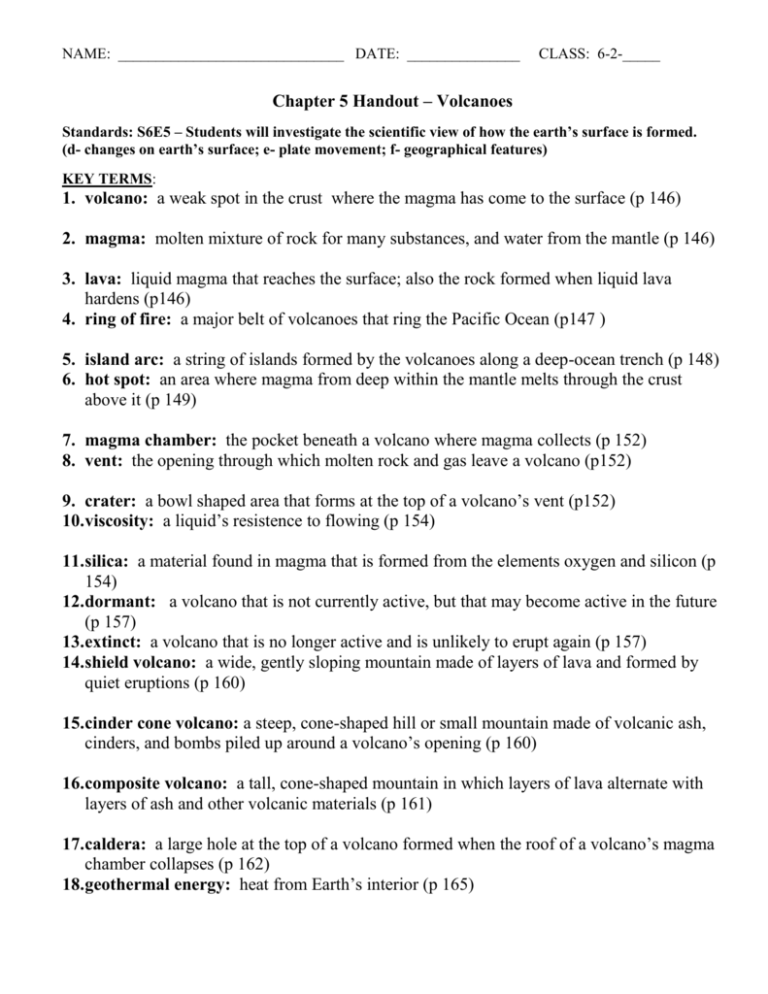File
advertisement

NAME: ______________________________ DATE: _______________ CLASS: 6-2-_____ Chapter 5 Handout – Volcanoes Standards: S6E5 – Students will investigate the scientific view of how the earth’s surface is formed. (d- changes on earth’s surface; e- plate movement; f- geographical features) KEY TERMS: 1. volcano: a weak spot in the crust where the magma has come to the surface (p 146) 2. magma: molten mixture of rock for many substances, and water from the mantle (p 146) 3. lava: liquid magma that reaches the surface; also the rock formed when liquid lava hardens (p146) 4. ring of fire: a major belt of volcanoes that ring the Pacific Ocean (p147 ) 5. island arc: a string of islands formed by the volcanoes along a deep-ocean trench (p 148) 6. hot spot: an area where magma from deep within the mantle melts through the crust above it (p 149) 7. magma chamber: the pocket beneath a volcano where magma collects (p 152) 8. vent: the opening through which molten rock and gas leave a volcano (p152) 9. crater: a bowl shaped area that forms at the top of a volcano’s vent (p152) 10.viscosity: a liquid’s resistence to flowing (p 154) 11.silica: a material found in magma that is formed from the elements oxygen and silicon (p 154) 12.dormant: a volcano that is not currently active, but that may become active in the future (p 157) 13.extinct: a volcano that is no longer active and is unlikely to erupt again (p 157) 14.shield volcano: a wide, gently sloping mountain made of layers of lava and formed by quiet eruptions (p 160) 15.cinder cone volcano: a steep, cone-shaped hill or small mountain made of volcanic ash, cinders, and bombs piled up around a volcano’s opening (p 160) 16.composite volcano: a tall, cone-shaped mountain in which layers of lava alternate with layers of ash and other volcanic materials (p 161) 17.caldera: a large hole at the top of a volcano formed when the roof of a volcano’s magma chamber collapses (p 162) 18.geothermal energy: heat from Earth’s interior (p 165) NAME: ______________________________ DATE: _______________ CLASS: 6-2-_____ Chapter 5 Handout – Volcanoes ESSENTIAL QUESTIONS: 1. Where do volcanic belts form? (p 147) along the boundaries of Earth’s plates 2. What type of plate boundary is associated with island arcs? (p 148) converging 3. What are 3 of the major island arcs? (p 148) Japan, New Zealand, Indinesia, Philippines, Aleutians, and Caribbean Islands 4. What is responsible for the formation of the Hawaiian Islands? (p 149) a hotspot 5. When a volcano erupts, the force of the expanding gases pushes magma from the magma chamber throughthe pipe until it flows or explodes out of the vent. (p 153) 6. The viscosity of magma depends on its silica content and temperature. (p 154) 7. If the volcano’s magma is low in silica, what type of eruption will it have? (p 154) quiet eruption 8. If the volcano’s magma is high in silica, what type of eruption will it have? (p 154) explosive eruption 9. An explosive eruption breaks lava into fragments of different sizes. List the 3 types of fragmenta in order of size from smallest to largest. (p 155) volcanic ash (fine, rocky particles as small as a speck of dust); cinders (pebble-sized particles): bombs (size ranges from baseballs to a size of a car) 10.What is the main hazard of a quiet eruption? (p 156) large areas can be covered with a thick layer of lava, burning everything in its path An explosive eruption? Belches/spews out hot clouds of deadly gases with ash, cinders, and bombs 11.What are the 3 terms used to describe a volcano’s stage activity? (p 157) active (live); dormant (sleeping); extinct (dead) 12.How do geologists monitor volcanoes? (p158) use of instruments that monitor/detect changes in/around volcano; gas escaping; temperature in underground water, small earthquakes 13.What triggers the small earthquakes associated with some volcanic eruptions? (p158) upward movement of magma triggers small earthquakes 14.What are the three types of volcanoes? (p 160) shield; cinder cone; composite 15.Groundwater heated by magma is a source of what type energy? (p 165) geothermal energy 16.Understand Figure 3, page 148 and how volcanoes form at each type of plate boundary.







